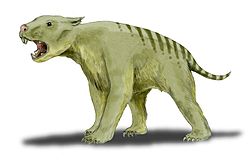| Vombatus | |
|---|---|
 | |
| Common wombat (Vombatus ursinus) | |
| Scientific classification | |
| Domain: | Eukaryota |
| Kingdom: | Animalia |
| Phylum: | Chordata |
| Class: | Mammalia |
| Infraclass: | Marsupialia |
| Order: | Diprotodontia |
| Family: | Vombatidae |
| Genus: | Vombatus É. Geoffroy, 1803 |
| Type species | |
| Vombatus ursinus Shaw, 1800 | |
Vombatus is a genus of marsupial that contains a single living species, the common wombat (Vombatus ursinus).
The recently extinct Hackett's wombat ( Vombatus hacketti ) is also a member of this genus. [1] [2]
| Image | Scientific name | Distribution |
|---|---|---|
 | Vombatus ursinus , common wombat |  |
| † Vombatus hacketti , Hackett's wombat | Southwest Australia |

